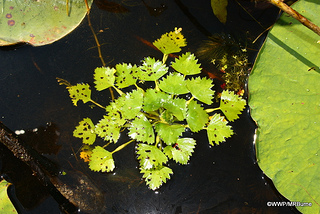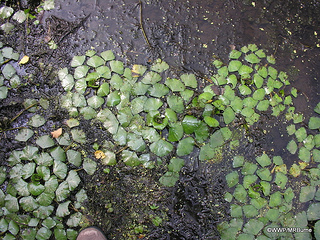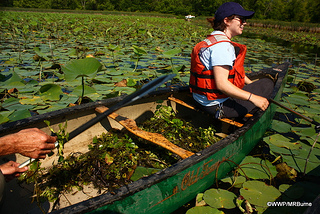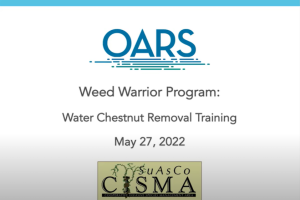Water Chestnut
(Trapa natans)
Family: Water Chestnut family (Trapaceae)
Native Range: Africa, Asia, Europe

Overview: Annual rooted, aquatic plant with both floating and submersed leaves.
Size: Stems can be 12-15 feet long
Leaves: Floating leaves form a rosette and are green, glossy and triangular with toothed edges. The submersed leaves are feathery and whorled around the stem.
Stem/Bark: Hollow, air-filled, and cord-like.
Flowers: Tiny, white four-petaled flowers that bloom in June.
Seed/Fruit: Nuts begin to form in July and have 4 sharp spines. Mature seeds are green to greenish brown and sink to the bottom. Each rosette can produce up to 20 hard seeds.
Roots: Fine roots anchor the plant.
Reproduction: The nuts can detach from the stem and float to another area on currents or by clinging to birds and other floating objects. The seeds can be viable in the soil for 12 years.
Identification
Ecological Threat
- Form dense floating mats, severely limiting light, shading out native plants
- Reduce water oxygen levels, increasing the potential for fish kills.
Human Impacts
- Property values along shorelines of infested waters may decrease.
- Dense mats can be difficult to get through in a boat, kayak, canoe, or when swimming.
- Sharp fruits can cause painful wounds when stepped on.
Distribution and Background
 Water chestnut plants were first introduced to North America in about 1874 and were known to be cultured in 1877 in the botanical garden of Asa Gray, the eminent Harvard University botanist. By 1879, plants were found in the Charles River in Massachusetts. Wild populations have since become established in many locations in the northeastern United States.
Water chestnut plants were first introduced to North America in about 1874 and were known to be cultured in 1877 in the botanical garden of Asa Gray, the eminent Harvard University botanist. By 1879, plants were found in the Charles River in Massachusetts. Wild populations have since become established in many locations in the northeastern United States.
Habitat Type
Although it prefers nutrient-rich lakes and rivers, water chestnut can grow in any freshwater setting, from intertidal estuaries to a depth of 12 feet in lakes and ponds. Report water chestnut seen or pulled here.
Management Options
Early detection is the key to control since smaller populations are easier to eliminate than larger ones. For larger populations chemical techniques followed by manual removal are the most effective. Any site with water chestnut must be managed/monitored for at least 12 years to ensure the seeds are no longer viable. OARS 2024 Water Chestnut Management Plan

Biological Control
- None currently available.
Manual Control
- Plants can be hand pulled, typically from canoes/kayaks
- Get as much root as possible
- Pull early in the season to reduce the volume of foliage you are boating around
- Plan for follow up pulls later in the season
Mechanical Control
- Mechanical harvesters can be used, however this should only be done when no other aquatic invasives are present as they can spread easily from the blades
Chemical Control
- Herbicides are effective but must be applied by a certified applicator and wetland permits need to be acquired.
- Typically applied to larger populations until manual removal is feasible.
Notice: Mention Of Pesticide Products On This Web Site Does Not Constitute Endorsement Of Any Material. See Control and Disposal Methods for descriptions of application types and warnings.
CAUTION: ANY ACTIVITIES IN AQUATIC SYSTEMS, INCLUDING REMOVAL OF INVASIVES BY HAND, REQUIRE A PERMIT UNDER YOUR LOCAL BYLAWS. SPEAK TO YOUR LOCAL CONSERVATION COMMISSION BEFORE STARTING WORK.
Disposal
- Compost above the high water line where there is no risk of the plants reentering the waterway
Look-alikes
None!
Alternative Native Species
Natives such as fragrant water lily (Nymphaea odorata), spatterdock (Nuphar variegata) and watershield (Brasenia schreberi) are attractive floating plants that occur in the same kinds of waters as water chestnut. Check with your local native plant society for recommendations and sources of native plants.
